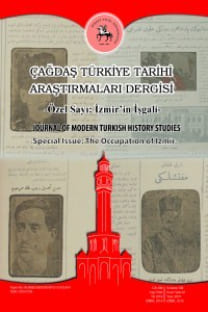YENİ ONBİNLER VE ANAKRONİK BİR SEFERİN AYAK İZLERİ
MÖ 401 yılında Atina ve Sparta'dan gelen paralı askerler de dahil olmak üzere Keyhüsrev komutasındaki kozmopolit bir ordu. Sardis'ten ayrılarak Anadolu'yu geçerek Mezopotamya'nın güneyindeki Kunaksa'ya indi. Kardeşi Pers Kralı Artaxerxes'in ordusuyla savaşan Keyhüsrev burada hayatını kaybetse de ordusu bir zafer kazanmıştı. Artaxerxes Yunan komutanları pusuya düşürüp öldürdükten sonra Atinalı Xenophon ve dört arkadaşı, Karadeniz kıyılarını takip ederek önce kuzeydoğuya, sonra Truva'ya kadar on binden fazla olan Yunan paralı askerlerine rehberlik etti. Xenophon, tehlike ve zorluklarla dolu bu uzun seferi Anabasis (Yükseliş) adlı kitabında anlatıyor.
Bu olaydan 2320 yıl sonra, 1919 baharında, on binlerce kişinin torunları ya da on binlerce yeni Yunan Albay Dimitri Ambelas'ın sözleriyle bu kez Selanik'ten ayrıldı. Yaklaşık üç buçuk yıl sonra 15 Mayıs sabahı İzmir'e inerek başlattıkları Anadolu seferi, tıpkı dedelerinki gibiydi. On binlerce insanın ve milyonlarca insanın ölümünün tarif edilemez acı ve ıstıraplar yaşamasına neden olan bu zamana Yunanistan'daki Küçük Asya Felaketi denir. Bu makalede Yunanlıların bölgeye neden ve nasıl geldikleri, ne yaptıkları ve nasıl örgütlendikleri, evlerine nasıl döndükleri incelenecektir.
Anahtar Kelimeler:
İzmir, Yunanistan, Milli Mücadele
NEW TENS OF THOUSANDS AND THE FOOTPRINTS OF AN ANACHRONISTIC EXPEDITION
A cosmopolitan army under the command of Keyhusrev, including mercenaries from Athens and Sparta, BC. He departed from Sardis in 401 and crossed Anatolia and landed in Kunaksa in the south of Mesopotamia. Although Keyhusrev, who was fighting with the army of his brother, Persian King Artaxerxes, lost his life here, his army had won a victory. After Artaxerxes ambushed and killed the Greek commanders, Xenophon of Athens and his four friends guided the Greek mercenaries, numbering more than ten thousand, first to the northeast and then to Troy, following the Black Sea coast. Xenophon describes this long expedition full of danger and hardship in his book Anabasis (Ascension).
2320 years after this event, in the spring of 1919, the grandchildren of tens of thousands, or in the words of Greek Colonel Dimitri Ambelas, new tens of thousands, this time departed from Thessaloniki. The Anatolian expedition they started by landing in İzmir on the morning of May 15th, after about three and a half years, was only like their grandfather's. It didn't end happily. This time, which caused the death of tens of thousands of people and millions of people to experience indescribable pain and suffering, is called the Asia Minor Disaster in Greece. In this article, it will be examined why and how the Greeks came to the region, what they did and how they were organized, as well as how they returned to their homes.
Keywords:
Smyrna, Greek, Turk National Struggle,
___
- ATASE Arşivi, Dolap: (52)-7, Dosya: (48)-12, Klasör: 404, Arşiv: 6/3420.
- Atrocites Greques en Asie Mineure, 3 em Partie, Imprimerie Hunsu Tabiate, Vis-a-vis de la Sublime Porte, Constantinople, 1922.
- BERBER, Engin; Sancılı Yıllar 1918-1922; Mütareke ve Yunan İşgali Yıllarında İzmir Sancağı, Ankara, Ayraç Yayınları, 1997.
- Xenophon; Anabasis, Harvard University Press, 1998;
- Ksenophon, Anabasis, 'Onbinlerin Dönüsü", Çeviren: Tanju Gökçöl, Hürriyet Yayınları, İstanbul, 1974.
- ISSN: 1300-0756
- Yayın Aralığı: Yılda 2 Sayı
- Başlangıç: 1991
- Yayıncı: Dokuz Eylül Üniv. - Atatürk İlkeleri ve İnkılap Tarihi Enst.
Sayıdaki Diğer Makaleler
İŞGAL VE KURTULUŞ; YUNAN İŞGALİNİN SONU, KÜÇÜK MENDERES BÖLGESİNİN KURTULUŞU
Günver GÜNEŞ, Filiz Akın ÖZCAN
TÜRK ORDUSUNUN İZMİR’E GİRİŞ SÜRECİNİN TÜRK BASININDAKİ YANSIMALARI (26 Ağustos 1922-13 Eylül 1922)
MİZAH PENCERESİNDEN TÜRK—YUNAN ÇATIŞMASI: SAVAŞ, DİPLOMASİ VE SİYASET (1919—1922)
THE UNITED STATES ATTITUDE IN THE PROCESS LEADING TO THE LIBERATION OF IZMIR (AUGUST-SEPTEMBER 1922)
İZMİR YANGINI HAKKINDAKİ TARTIŞMALAR ÜZERİNE BİR İNCELEME
YENİ ONBİNLER VE ANAKRONİK BİR SEFERİN AYAK İZLERİ
KARA GÜNDEN AK GÜNE İZMİR VE İZMİR YANGININ BASINA YANSIMASI
